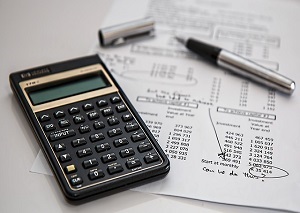Topic: Blue Chip Stocks
The Ins and Outs of Capital Gains Tax for Investors
Capital gains occur when an investor sells an asset. To calculate capital gains, the total of the adjusted cost base (ACB) is subtracted from the proceeds of the sale. The adjusted cost base of the shares is equal to the cost of the shares plus any costs associated with buying and selling them, such as brokerage commissions. If the remainder is positive, then the investor has a capital gain. If the remainder is negative, the investor then has a capital loss.
 True Blue Chips pay offLearn everything you need to know in 'The Best Blue Chips for Canadian Investors' for FREE from The Successful Investor. Canadian Blue Chip Stocks: Bank of Nova Scotia Stock, CP Rail Stock, CAE Inc. Stock and more. |
Ins and outs of calculating capital gains tax for Canadian investors
Calculating capital gains tax is important for investors so they know how much they owe—and how much they are saving
Did you know that Canadian capital gains taxes are actually taxed at a much lower rate than interest? Let’s take a look at the process for calculating capital gains tax.
For example, let’s say you buy a stock for $1,000 and then sell that stock for $2,000. You then have a $1,000 capital gain (not including brokerage commissions). You would then pay capital gains tax on 50% of the capital gain amount. This means that if you earn $1,000 in capital gains, and you are in the highest tax bracket in, say, Ontario (49.53%), you will pay $247.65 in capital gains tax on the $1,000 in gains.
In contrast, interest income is fully taxable, while dividend income is eligible for a dividend tax credit in Canada. In the 49.53% tax bracket, you’d pay $495.30 in taxes on $1,000 in interest income, and you would pay roughly $295.20 on $1,000 in dividend income.
If you’ve bought shares of the same company more than once, the adjusted cost base you need to calculate your capital gains tax is equal to the average cost of each share. You can determine the average cost by dividing the total cost of all the shares you’ve purchased by the total number of shares you hold.
One of the main advantages capital gains have over other forms of investment income is that you control when you pay capital-gains tax. This amounts to a very simple and highly effective way of deferring tax—and it’s perfectly legal.
You pay capital gains tax on a stock only when you sell, or “realize” the increase in the value of the stock over and above what you paid for it. In contrast, interest and dividend income are taxed in the year in which they are earned.
As an added bonus, if you sell after you retire, you may be in a lower tax bracket than you are at an earlier stage in your investing career. In any event, the longer you hold onto a profitable stock and put off paying capital gains tax, the longer all of your money works for you.
This can have a significant impact on your long-term returns. To continue with the example above, if you buy stock for $1,000 and then sell that stock for $2,000, you will pay $247.65 in capital gains tax. That would leave you with $1,752.35 to reinvest (not including brokerage commissions).
However, if you hang onto the stock, you keep the full $2,000 working for you until you choose to sell. That holds out the potential for even further gains, and the possibility of paying less tax on your capital gains if you sell after you retire, when you may be in a lower tax bracket.
Dividend payments don’t affect your capital gains tax—unless they’re reinvested into additional shares. Dividend payments in cash do not change the shares’ adjusted cost base. You pay tax on the dividends as received each year at the rate on dividends, not capital gains.
However, if the dividend payments are reinvested in additional shares of stock, then the total cost and total number of shares change after each new dividend reinvestment, and you must recalculate your new adjusted cost base. Note that you must still pay taxes on reinvested dividends each year as received.
4 Investing strategies for taxable capital gains
Below we share taxable capital gains strategies for getting the most from your investments.
Tax-free saving accounts as a way to cut taxable capital gains Tax-free savings accounts let you earn investment income—including interest, dividends and capital gains—tax free. But unlike registered retirement savings plans (RRSPs), contributions to TFSAs are not tax deductible.
If funds are limited, you may need to choose between TFSA and RRSP contributions.
RRSPs may be the better choice in years of high income, since RRSP contributions are deductible from your taxable income. In years of low or no income—such as when you’re in school, beginning your career or between jobs—TFSAs may be the better choice.
Moreover, investing in a TFSA in low-income years will provide a real benefit in retirement. When you’re retired, you can draw down your TFSA first, and then begin making taxable RRSP withdrawals.
Tax loss selling as a way to cut taxable capital gains You pay capital gains tax on a stock only when you sell, or “realize” the increase in the value of the stock over and above what you paid for it. In contrast, interest and dividend income are taxed in the year in which they are earned. As an added bonus with capital gains, if you sell after you retire, you may be in a lower tax bracket than you are when you are earlier in your investing career.
In any event, the longer you hold onto a profitable stock and put off paying capital gains tax, the longer all of your money works for you. If you hang onto the stock, you keep the full $2,000 working for you until you choose to sell. That holds out the potential for even further gains, and the possibility of paying less tax on your added capital gains if you sell after you retire, when you may be in a lower tax bracket.
It’s always a good time to sell bad stocks, or stocks that are wrong for your portfolio. But note that in the final couple of months of the year, some investors dump stocks without thinking, just to cut their taxes. In some cases, they simply want to sell and be done with it. If you’re not in a hurry, you might want to sell before or after that time of year.
Making an adult child co-owner of your home can have hidden taxable capital gains consequences If you have capital gains on your portfolio, you are only liable for capital gains taxes when you sell. But if you put your son or daughter on as a co-owner, the Canada Revenue Agency could interpret that as a “deemed disposition” —the sale, in other words—of half the portfolio. That would leave you liable for capital gains tax this year, rather than deferring those gains until you sell or die.
When you die, you are deemed to have disposed of or sold your entire portfolio. But no matter how old you are, that day can still be years in the future. It’s a waste to pay capital gains tax any sooner than you have to. Worse, your stocks may have gone down by the time you die. The gain on which you’ve already paid taxes may have evaporated!
You won’t have this exact problem if you put an adult child on as co-owner of your home, since capital gains on your principal residence are tax-exempt. But each of us can only have one principal-residence capital-gains-tax exemption. If your adult child already owns a home, then any gains he or she makes on your home, after becoming joint owner, will be taxable.
In this case, putting your adult child on as co-owner of your home could convert some tax-free capital gains (in your hands) into taxable capital gains (in your child’s hands).
Make sure you claim all of your deductions against taxable capital gainsCommissions and brokers’ fees aren’t the only expenses you can deduct when you sell your capital property. You can deduct many other outlays and expenses that you incur to sell your property, including fixing-up expenses, finders’ fees, surveyors’ fees, legal fees, transfer taxes and advertising costs. To ensure that you’re claiming all of the deductions you can, and doing so correctly, we advise that you consult a knowledgeable tax professional.
3 Strategies for maximizing your capital gains deduction
As Canadian capital gains tax is lower than the tax on interest and on dividend income, capital gains is a very tax-advantaged form of income. However, since most investors have income of all three types, here are three strategies for structuring investment portfolios to minimize the tax burden.
- It is usually best to hold any common shares outside of an RRSP (as dividend income and capital gains taxes are taxed lower than interest income), and interest-paying investments in an RRSP. If you only hold common shares, they are okay to hold in an RRSP.
- More speculative investments are best held outside of an RRSP. If investors hold them in an RRSP and they drop, investors not only lose money, but they can’t use the losses to offset any taxable gains from other investments.
- Regarding mutual funds outside an RRSP, the main consideration is that mutual funds make annual capital gains distributions even if investors continue to hold the fund units. Investors then pay Canadian capital gains tax on half of any realized capital gains. So you are best to hold mutual funds in an RRSP and common stocks outside. You won’t realize capital gains on common stocks until you sell.
A properly structured investment portfolio can let you take advantage of the low tax rate on capital gains and dividend income while sheltering your higher-taxed interest income in your RRSP. If you make dividends or capital gains in an RRSP, you gain the tax shelter of the RRSP, but when you withdraw the funds from your RRSP they are taxed at the same rate as interest income. This means you would lose out on the lower tax rates offered.
Holding Speculative Stocks In Your RRSP Can Increase Your Capital Gains Tax
One key rule is that it’s best to hold speculative investments outside your RRSP. Losses are inevitable with speculative investments. If you hold them outside your RRSP, losses provide you with tax-deductible capital losses that can reduce your payable capital gains tax. Inside your RRSP, losses simply reduce the capital you have available to take advantage of an RRSP’s tax-deferral power.
It’s especially crucial to observe this rule when you’re young. Your RRSP’s tax-deferral power continues until you take all the money out, and by then you may be in your 90s. A capital loss in your RRSP deprives you of this benefit, which is the most valuable part of an RRSP.
There is something to be said for holding interest-paying investments and foreign stocks in your RRSP, and Canadian stocks outside of it. That’s because dividend income from Canadian stocks is eligible for the dividend tax credit, where interest income and foreign dividends get taxed as ordinary income.
High-Quality Stocks Beat Bonds As RRSP Investments
Some financial planners say that stocks are too speculative to hold in an RRSP, because of the risk. That view made sense a decade or two ago, when interest rates were two or more times higher than they are today. Now the situation has reversed. With interest rates now at historic lows, bonds can’t go a lot higher than they are. In fact, it seems more likely that rates will hold steady or rise slightly in the short term, and move higher still in the long run. That means bond investors would only earn interest income on their bonds; instead of capital gains, their bond holdings could produce capital losses.
Capital Gains: Should you be selling your stocks in the first place?
Stock prices tend to move in short spurts, interrupted by lengthy periods when they mainly move sideways. For this reason, sometimes investors who only focus on price, rather than the fundamentals of their investments, may make changes just for the sake of change.
Selling stocks because you are bored with them is not the kind of mistake that brings immediate losses, but it’s sure to cut deeply into your long-term returns. The reason is that the market’s top performers can bore you to tears for months or years at a time. However, even though they may go sideways for a long time, these stocks may then set off on a big rise. If you sell out of boredom, you would miss that rise.
Use these three tips to see if you should be selling your stocks in the first place.
- Be quicker to sell low-quality stocks, and slower to sell shares of high-quality stocks.
- Before you sell, ask yourself this: does the stock have a poor fundamental outlook? Or do you want to sell because it just isn’t going up fast enough (see boredom above)?
- Avoid portfolio tinkering, especially when it comes to selling stocks that you feel have gone up too far and too fast. To succeed as an investor, you need a big winner in your portfolio from time to time. One key fact about big winners is that they tend to go up further and faster than most investors expect, and they keep doing it for years if not decades.
Follow our three-part Successful Investor strategy
- Invest mainly in well-established companies;
- Spread your money out across most if not all of the five main economic sectors (Manufacturing & Industry; Resources & Commodities; the Consumer sector; Finance; Utilities);
- Downplay or avoid stocks in the broker/media limelight.
What strategies are you using to manage your capital gains taxes? Share your experiencewith us in comments.
This post was originally published in 2017 and is regularly updated.




When one sells the Principal Residence can the various selling costs such as legal and real estate fees be deductable from other income such as pensions?
Hi, Richard, for this type of tax question, we recommend consulting your accountant for advice specific to your situation.